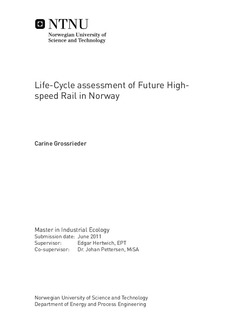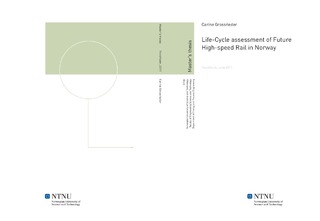| dc.description.abstract | The aim of this study is to provide an overview of the core factors for the environmental performance of future Norwegian high-speed rail (HSR) and to study their likely development up to 2050 in a life-cycle assessment (LCA) perspective. The analysis included the infrastructure, rolling stock and operations. This work was conducted with MiSA, an environmental consulting company based in Trondheim, Norway. MiSA recently completed a life-cycle inventory (LCI) for HSR in Norway. To start with, core factors were chosen through a literature review. The corridor Oslo-Trondheim was then modeled using the new LCI in order to establish a set of the core factors to analyze. The LCA was performed with SimaPro. LCA literature is the preferred source for emissions data. First because results show that emissions must cover life-cycle emissions from fuel, electricity, materials and processing (source-to-wheel). Second, LCA provides guidelines for good practice for environmental accounting and benchmarking of transport alternatives. Chapter 4 is an investigation of the core factors. Through the study of technical writings for current and future use of HSR in Norway, as well as sensitivity analyses, certain core factors were earmarked to produce detailed scenarios for future use up to 2050.Cement, steel, XPS, infrastructure, deforestation and the number of passengers per day are core factors. Cement, steel and XPS are the materials that have the most impact. The impact of the infrastructure of future Norwegian HSR is high because the number of passengers and the carbon footprint (CF) of the electricity mix used for operation are low. Norwegian HSR is lacking passengers. A high number of passengers in the Norwegian context constitutes a low number of passengers in other European countries. A high potential for change is to abstract passengers from air travel, which is the most used mode of transport in Norway in 2010. The energy used for operation and the energy per seat-km are not core factors because the electricity mix used for operation has a low CF (166 g CO2/kWh). The impact of HSR is reduced on average by 17% by updating the database (scenario updated 2010). The impact is reduced by 50% in a likely future (scenario 2050) by improving the production technology of the materials for the infrastructure and by having more passengers. Finally, the impact is reduced by 60% by, in addition to changes from scenario 2050, setting specific requirement to the suppliers and by having an active yield management (scenario 2050+). | nb_NO |

